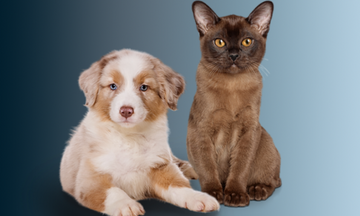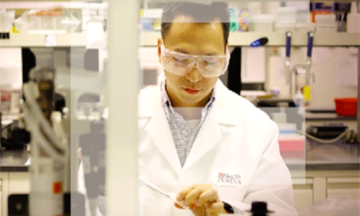微生物叢の基礎知識

遺伝は、 微生物叢の構成で重要な役割を果たしています。1遺伝的関係にある犬の間で腸内微生物叢を比較したところ、離乳以降地理的に離れていたとしても、遺伝的関係のない犬と比較したときよりも、類似していることがわかりました。2
腸管の微生物コロニーの形成は、当初は母犬の微生物叢、環境、栄養に影響されます。
生後 7 週間の仔犬の微生物叢は、出生時に比べ、母犬の微生物叢とより類似していました。2仔犬の微生物叢は、微生物の多様性と種の豊富さが生後 2 日から 56 日まで増加した後、生後 42 日後までには比較的安定します。3これに対し、仔猫の微生物叢は生後 4 週間から 8 週間の間に多様性が減少します。4
あるメタゲノミクス研究では、仔猫の微生物叢は生後 8 週から 16 週の間にほとんど変化しないことが示唆され 5、別の研究では生後 18 週から 30 週の間に構造的および機能的多様性の変化が見られましたが、30 週から 42 週には有意な変化は観察されませんでした。6

年齢、病気、治療、その他のストレスにより、腸内細菌のバランスは、病原性の可能性がある細菌の割合が増加する方向に変化します。3,7,8
また、ペットの生活環境も、腸内微生物叢に劇的な影響を与える可能性があります。飼い犬の微生物叢は、保護施設の犬のそれとは異なり、後者の方がより多様な微生物叢集団を示しています。1大都市で生活する犬は、小さな町や地方で生活する犬と比べ、より多様な微生物叢があることが明らかになっています。2
多くの疾患は腸内微生物叢の異常(ディスバイオシス)と関連性がありますが、その微生物叢の異常が疾患の原因か結果かは、明確になっていません。1
微生物叢の異常は、慢性腸疾患、慢性下痢症、または急性下痢症を発症した犬で観察されています。9,10
医薬品が微生物叢に影響を及ぼすことがあります。
特に抗菌薬(メトロニダゾールやタイロシンなど)は、微生物叢を大きく変化させることがあります。1,11,12オメプラゾールなどのプロトンポンプ阻害薬も微生物叢に悪影響を及ぼします。1,13
肥満は、微生物叢の変化と関連性がありますが、肥満の原因または結果としての微生物叢の役割ついてはまだ明らかになっていません。14,15
肥満犬の微生物叢は、やせ型の犬の微生物叢に比べ、食餌の内容に対する反応が異なり、強靭性が低いことがわかっています。15,16
腸内細菌叢の構成は、食餌の内容に大きく影響されます。
微生物叢は、原材料(成分)分析データ、栄養濃度、消化率、食餌の加工手順の影響を受ける可能性があります。17-24マクロ栄養素(タンパク質、炭水化物、脂質)の含有率は、微生物叢の構成に変化を生じさせる最も重要な食餌要因であると考えられます。17,24-29タンパク質を豊富に含む食餌により、タンパク質を分解する細菌の量が増える一方、炭水化物を豊富に含む食餌により、糖を分解する細菌の量が増加します。23
腸内微生物叢は食餌に反応して急速に変化するため 17,30,31、微生物叢の構成にはきわめて高い柔軟性があることが示されています。ただし、こうした変化は可逆的であり、犬に元の食餌を与えれば、微生物叢の構成も元に戻ります。30,31
微生物叢フォーラムの他の領域を見る
詳しく知る
- Belas, A., Marques, C., & Pomba, C. (2020).The gut microbiome and antimicrobial resistance in companion animals.In Duarte, A. & Lopes da Costa, L. (Eds.), Advances in Animal Health, Medicine and Production (1st ed.), pp. 233–245.Springer International Publishing
- Vilson, Å., Ramadan, Z., Li, Q., Hedhammar, Å., Reynolds, A., Spears, J.,…Hansson-Hamlin, H. (2018). Disentangling factors that shape the gut microbiota in German Shepherd dogs. PLoS ONE, 13(3), e0193507. doi:1371/journal.pone.0193507
- Guard, B. C., Mila, H., Steiner, J. M., Mariani, C., Suchodolski, J. S., & Chastant-Maillard, S. (2017). Characterization of the fecal microbiome during neonatal and early pediatric development in puppies. PLoS ONE, 12(4), e0175718. doi:10.1371/journal.pone.0175718
- Jia, J., Frantz, N., Khoo, C., Gibson, G. R., Rastall, R. A., & McCartney, A. L. (2011). Investigation of the faecal microbiota of kittens: monitoring bacterial succession and effect of diet. FEMS Microbiology Ecology, 78, 395–404. doi:10.1111/j.1574-6941.2011.01172.x
- Deusch, O., O’Flynn, C., Colyer, A., Morris, P., Allaway, D., Jones, P. G., & Swanson, K. S. (2014).Deep Illumina-based shotgun sequencing reveals dietary effects on the structure and function of the fecal microbiome of growing kittens. PLoS ONE, 9(7), e101021. doi:10.1371/ journal.pone.0101021
- Deusch, O., O’Flynn, Colyer, A., Swanson, K. S., Allaway, D., & Morris, P (2015). A longitudinal study of the feline faecal microbiome identifies changes in to early adulthood irrespective of sexual development. PLoS ONE, 10(12), e0144881. doi: 10.1371/journal.pone.0144881
- Romano-Keeler, J., & Weitkamp, J. H. (2015). Maternal influences on fetal microbial colonization and immune development. Pediatric Research, 77(1–2), 189–95. doi:10.1038/pr.2014.163
- Young, W., Moon, C. D., Thomas, D. G., Cave, N. J., & Bermingham, E. N. (2016). Pre- and post-weaning diet alters the faecal metagenome in the cat with differences vitamin and carbohydrate metabolism gene abundances. Scientific Reports, 6, 34668. doi:10.1038/srep34668
- Honneffer, J. B., Minamoto, Y., & Suchodolski, J. S. (2014). Microbiota alterations in acute and chronic gastrointestinal inflammation of cats and dogs. World Journal of Gastroenterology, 20(44), 16489–16497. doi:10.3748/wjg.v20.i44.16489
- Suchodolski, J. S., Markel, M. E., Garcia-Mazcorro, J. F., Unterer, S., Heilmann, R. M., Dowd, S. E.,…Toresson, L. (2012). The fecal microbiome in dogs with acute diarrhea and idiopathic inflammatory bowel disease. PLoS ONE, 7(12), e51907. doi:10.1371/journal.pone.0051907
- Igarashi, H., Maeda, S., Ohno, K., Horigome, A., Odamaki, T., & Tsujimoto, H. (2014). Effect of oral administration of metronidazole or prednisolone on fecal microbiota in dogs. PLoS ONE, 9(9), e107909. doi:10.1371/journal.pone.0107909
- Suchodolski, J. S., Dowd, S. E., Westermarck, E., Steiner, J. M., Wolcott, R. D., Spillmann, T., & Harmoinen, J. A. (2009). The effect of the macrolide antibiotic tylosin on microbial diversity in the canine small intestine as demonstrated by massive parallel 16S rRNA gene sequencing. BMC Microbiology, 9, 210. doi:10.1186/1471-2180/9/201
- Garcia-Mazcorro, J. F., Suchodolski, J. S., Jones, J. R., Clark-Price, S. C., Dowd, S. E., Minamoto, Y.,…Dossin, O. (2012). Effect of the proton pump inhibitor omeprazole on the gastrointestinal bacterial microbiota of healthy dogs. FEMS Microbiology Ecology, 80, 624-636.
- Handl, S., German, A. J., Holden, S. L., Dowd, S. E., Steiner, J. M., Heilman, R. M.,…Suchodolski, J. S. (2013). Faecal microbiota in lean and obese dogs. FEMS Microbiology Ecology, 84, 332343. doi: 10.1111/1574-6941.12067
- Li, Q., Lauber, C. L., Czarnecki-Maulden, G., Pan, Y., & Hannah, S. S. (2017). Effects of the Dietary Protein and Carbohydrate Ratio on Gut Microbiomes in Dogs of Different Body Conditions. MBio, 8(1), e01703–16. doi:10.1128/mBio.01703-16.
- Xu, J., Verbrugghe, A., Lourenco, M., Cools, A., Lui, D. J. X., Van de Wiele, T.,…Hesta, M. (2017). The response of canine faecal microbiota to increased dietary protein is influenced by body condition. BMC Veterinary Research, 13, 374. doi:10.1186/s12917-017-1276-0
- Do, S., Phungviwatnikul, T., de Godoy, M. R. C., & Swanson, K. S. (2021). Nutrient digestibility and fecal characteristics, microbiota, and metabolites in dogs fed human-grade foods. Journal of Animal Science, Epub ahead of print. doi:10.1093/jas/skab028/6123189
- Bermingham, E. N., Young, W., Kittelman, S., Kerr, K. R., Swanson, K. S., Roy, N. C., & Thomas, D. G. (2013). Dietary format alters fecal bacterial populations in the domestic cat (Felis catus). Microbiology Open, 2(1), 173–181. doi:10.1002/mbo3.60
- Kim, J., An, J.-U., Kim, W., Lee, S., & Cho, S. (2017). Differences in the gut microbiota of dogs (Canis lupus familiaris) fed a natural diet or a commercial feed revealed by the Illumina MiSeq platform. Gut Pathogens, 9, 68. doi:10.1186/s13099-017-0218-5
- Sandri, M., Dal Monego, S., Conte, G., Sgorlon, S., & Stefanon, B. (2017). Raw meat based diet influences faecal microbiome and end products of fermentation in healthy dogs. BMC Veterinary Research, 13, 65. doi:10.1186/s12917-017-0981-z
- Algya, K. M., Cross, T.-W. L., Leuck, K. N., Kastner, M. E., Baba, T., Lye, L., de Godoy, M. R. C., & Swanson, K. S. (2018). Apparent total-tract macronutrient digestibility, serum chemistry, urinalysis, and fecal characteristics, metabolites and microbiota of adult dogs fed extruded, mildly cooked, and raw diets. Journal of Animal Science, 96, 3670-3683. doi:10.1093/jas/sky235
- Hill, S. R., Rutherfurd-Markwick, K. J., Ravindran, G., & Thomas, D. G. (2015). The effects of differing proportions of dietary macronutrients on the digestibility and post-prandial endocrine responses in domestic cats (Felis catus). Journal of Applied Animal Nutrition, 3, e4. doi:10.1017/ jan.2015.2
- Schmidt, M., Unterer, S., Suchodolski, J. S., Honneffer, J. B, Guard, B. C., Lidbury, J. A.,…Kölle, P. (2018). The fecal microbiome and metabolome differs between dogs fed Bones and Raw Food (BARF) diets and dogs fed commercial diets. PLoS ONE, 13(8), e0201279. doi:10.1371/journal.pone.0201279
- Pilla, R., & Suchodolski, J. S. (2021).The gut microbiome of dogs and cats, and the influence of diet. Veterinary Clinics of North America Small Animal Practice, 51(3), 605-621. doi:10.1016/j.cvsm.2021.01.002
- Vester, B. M., Dalsing, B. L., Middlebos, I. S., Apanavicius, C. J., Lubbs, D. C., & Swanson, K. S. (2009). Faecal microbial populations of growing kittens fed high- or moderate-protein diets. Archives of Animal Nutrition, 63(3), 254–265.
- Hooda, S., Vester Boler, B. M., Dowd, S. E., Swanson, K. S. (2012). The gut microbiome of kittens is affected by dietary protein:carbohydrate ratio and correlated with blood metabolite and hormone concentrations. British Journal of Nutrition, 109, 1637–1646. doi:10.1017/S0007114512003479
- Bermingham, E. N., Kittelman, S., Young, W., Kerr, K. R.. Swanson, K. S., Roy, N. C., & Thomas, D. G. (2013). Post-weaning diet affects faecal microbial composition but not selected adipose gene expression in the cat (Felis catus). PLoS ONE, 8(11), e80992. doi:10.1371/ journal.pone.0080992
- Bermingham, E. N., Maclean, P., Thomas, D. G., Cave, N. J., & Young, W. (2017). Key bacterial families (Clostridiaceae, Erysipelotrichaceae and Bacteroidaceae) are related to the digestion of protein and energy in dogs. PeerJ, 5, e3019. doi:10.7717/peerj.3019
- Mori, A., Goto, A., Kibe, R., Oda, H., Kataoka, Y., & Sako, T. (2019). Comparison of the effects of four commercially available prescription diet regimens on the fecal microbiome in healthy dogs. Journal of Veterinary Medical Science, 81(12), 1783–1790. doi:10.1292/jvms.19-0055
- Herstad, K. M. V., Gajardo, K., Bakke, A. M., Moe, L., Ludvigsen, J., Rudi, K.,…Skancke, E. (2017). A diet change from dry food to beef induces reversible changes on the faecal microbiota in healthy, adult client-owned dogs. BMC Veterinary Research, 13, 147. doi:10.1186/s12917-017-1073-9
- Allaway, D., Haydock, R., Lonsdale, Z. N,, Deusch, O. D., O’Flynn, C., & Hughes, K. R. (2020). Rapid reconstitution of the faecal microbiome after extended diet-induced changes indicate a stable gut microbiome in healthy adult dogs. Applied Environmental Microbiology, Epub ahead of print. doi:10.1128/AEM.00562-20


